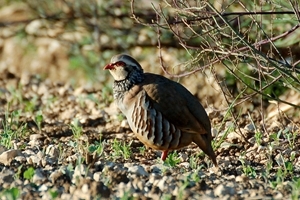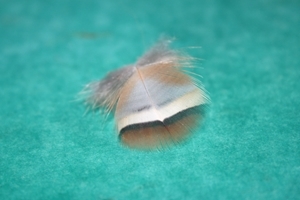By Mike Swan, GWCT Head of Education
 Once upon a time there was a bird called an Ogridge. It was the invention of the now long gone Ormsby Game Services, of Louth in Lincolnshire. A hybrid between a redleg cock and a chukar hen, it was proclaimed as the partridge of the future. These two species of Alectoris are so close genetically that they are inter fertile, and at first glace the offspring look so much like a pure redleg that you would hardly notice the difference.
Once upon a time there was a bird called an Ogridge. It was the invention of the now long gone Ormsby Game Services, of Louth in Lincolnshire. A hybrid between a redleg cock and a chukar hen, it was proclaimed as the partridge of the future. These two species of Alectoris are so close genetically that they are inter fertile, and at first glace the offspring look so much like a pure redleg that you would hardly notice the difference.
Back in the 1960s and early 70s, when the idea of rearing and releasing redlegs in much the same way as pheasants was relatively new, producers hit on a problem. Unlike first year pheasants and grey partridges, young redleg hens do not lay many eggs. A dozen per hen was considered good, compared to over 30 from a pheasant. To get even this sort of production, you need early hatched birds, and I often heard from someone who had bought a “breeding stock” of late ones, only to get no eggs from most of them in the first spring.
So, unlike pheasants, it is still normal to keep redleg stock to the second and third year, when they will lay many more eggs. Meanwhile, the clever people at Ormsby Game Services realised that the closely related chukar (Alectoris chukar) was already in semi-domestication out east, and that it is far more productive and comes into lay earlier. However, it is obviously different to look at, rather tamer and dare I say lazier; hence the idea of crossing, perhaps hoping for hybrid vigour. Meanwhile, by specifically choosing the chukar as the female parent, they got her productivity, without her offspring having too outlandish a look.
Cross-bred partridges
So, by the time I started my GWCT career in 1982, chukar crosses were the bread and butter released partridge. But, there was a glitch: the chukar was not on the “British List” and was therefore an alien species under the terms of the Wildlife and Countryside Act, 1981. This prohibited release, but licences were issued, and life carried on.
Meanwhile, GWCT scientists were observing the fact that hybrids were very poor at rearing young in the wild, producing only 20% of what pure redlegs manage. So, when government suggested that chukars and their hybrids should be phased out, we could hardly argue. There was no science to support them, and the GWCT always sticks to the science. Some of our members resigned over the issue, and the prophets of doom said that this would be the end of partridge shooting as we knew it.
A better flier
Roll on to 1992, when the release licence finally ran out, and guess what: “These pures fly much better than the chukars.” I lost count of the times I heard those words on shoots that autumn – chalk one up for the GWCT being right to stick to its guns.
Everything was rosy for a few years, and then shoots began to report problems. Redleg drives that had worked beautifully began to fail. What had gone wrong? Well, I have a hunch that the lazy chukars were coming back, because they had never quite been cleaned out. As mentioned above, even a half cross looks very like a pure redleg, so anyone that had been dealing with hybrids could easily have missed the odd crossbred in their stock during the pre-1992 clear out.
Higher productivity
 Remember, the original reason for the chukar was its higher productivity. So, if there are any birds with chukar genes, those genes are likely to increase rapidly through the generations, meaning that a minor taint probably rapidly became major contamination. Add in the cheap alternative of using caught-up birds rather than a properly selected and over-wintered breeding stock, and the fat lazy cross that would not face the Guns is favoured even more.
Remember, the original reason for the chukar was its higher productivity. So, if there are any birds with chukar genes, those genes are likely to increase rapidly through the generations, meaning that a minor taint probably rapidly became major contamination. Add in the cheap alternative of using caught-up birds rather than a properly selected and over-wintered breeding stock, and the fat lazy cross that would not face the Guns is favoured even more.
A quick look in the game larder at one lot of birds from a shoot with problems corroborated this. Half of the birds had chukar plumage characteristics. Redlegs have just one black bar on the flank feathers, while chukars have two. If you can see a hint of a second bar as in the picture, you are looking at a cross.
Will they stay?
Lots of shoots that put out a few redlegs end up with poor returns, and they perhaps wonder about whether they have chosen the right strain. However, I don’t think there is the same variation as with pheasants, unless there is chukar contamination. Unlike pheasants, there are not lots of different races to choose between. Also, we should remember that pheasants have been partially domestic, and getting fat and lazy like most livestock, since Roman times. Meanwhile, redlegs have only been captive bred in numbers since the 1960s.
Now, it is perfectly possible to buy rubbish, and as with all things, the cheapest price rarely equates with best value for money. As always, be prepared to ask questions of your game farmer. Anyone who is serious about redlegs will be maintaining a closed flock, with no caught-up birds. They will likely be checking for signs of chukar plumage, and culling anything suspect. That said, they may well source their eggs from trusted suppliers in France or Spain. Either way, breeding stock will be carefully selected from early hatched birds, to maximise first season output. A good game farmer should welcome you wanting to come to see the operation and discuss your needs, but expect to turn up in a clean vehicle, use boot dips, and follow a serious hygiene protocol. If the operation is slapdash, go elsewhere.
Getting good results
It is my view that if returns are poor, then either we are not managing them properly on shoot days, or the habitat is not up to scratch. Everyone seems to get excited about the partridge that turns up in the drive, indeed my old mate, the late Monty Wilcox said: “If they are shooting too many pheasants, shout partridge forward, and they will all stop shooting and look for it!” So, time and again pheasant shoots add a few redlegs for colour and interest.
This can work well, but it is easy to forget that they may not want to go where the pheasants do, and if the majority tend go out of the side, then returns will be poor even though they stay well. If you are happy with this, that’s fine, but if you want a decent return, you probably need to plan on putting out enough to have some proper early season partridge days, and then enjoy the rest as an adjunct to the pheasants.
The other cause of failure is making the mistake of thinking that they will like the same habitat as pheasants. In their native lands, redlegs are birds of scrub, maquis, olive groves and orchards. They are not really the open country bird that the grey is, nor do they much like mature woodland. They can adapt quite well to arable land, with its stubbles and winter crops, but grass farming is not their thing. If your shoot is basically just permanent pasture, silage grass, and woods, you should expect them to stray. If in doubt, please remember that your local GWCT advisor would be happy to visit and help you weigh things up.
Redlegs are great fun, and have long filled a gap in the shooting programme, providing wonderful autumn sport, and then adding variety and excitement to the pheasant days of winter. They are not the easiest birds to manage, but given commitment, and attention to their individual needs, they are a wonderful addition to many shoots, often giving better returns than pheasants.
This blog was first published as an article in Shooting Times.